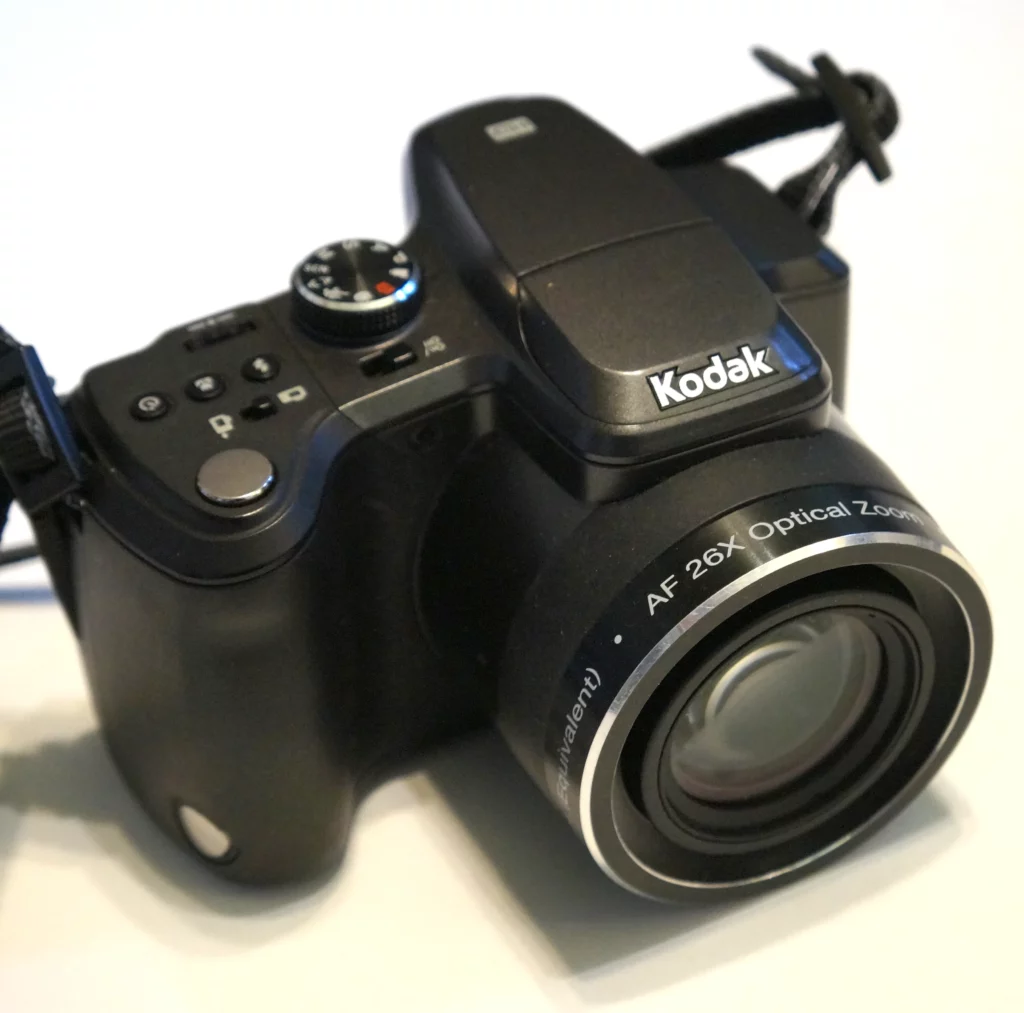
The Kodak EasyShare Z981 was made toward the end of Kodak’s production of digital cameras (the Kodak cameras you can buy today are made by a different company that licenses the trademark), and it is one of the worst and one of the best superzooms Father Pitt has ever used. It’s poorly made, slow, and buggy, but old Pa Pitt keeps picking it up anyway.
Kodak tried to appeal to the enthusiast market with its high-end Z series, but compromises made this camera less appealing to photographers, while complexity made it less appealing to casual picture-takers.
The construction is appallingly cheap, and bits of plastic are likely to break—the battery-door hinge is broken on this one, for example, though to be fair battery doors are the most common physical point of failure in cameras that take AA batteries. A rubber band keeps the camera working.
If you save raw files, the camera is so slow that one reviewer suggested you put the kettle on between shots. (But, on the other hand, it does save raw files, so it earns points for that.)
At speeds of ISO 400 or above, the noise in raw files is pretty bad, and the in-camera JPEGs are smeary with noise reduction.
As with every Kodak Z-series camera Father Pitt has used, autofocus is fiddly, and in some modes simply doesn’t work at the long end of the zoom.
But at ISO 64, this camera produces gorgeous pictures. The Schneider lens deserves a much better camera behind it. There is very little distortion for such a long lens, although the wide-end barrel distortion is noticeable because the camera does no correction—it has to be corrected in software later. The camera itself allows a high degree of manual control over most things, and the electronic viewfinder is good enough to make manual focusing possible.
The pictures are the main reason old Pa Pitt keeps picking up this camera again. Under the right conditions, the pictures are clear and sharp. Father Pitt always saves the pictures in raw format, in spite of the wait between shots. Even at the base ISO of 64 they can use a little noise reduction, but they respond well to it.
The camera has plenty of quirks. Autofocus is, as we said, fiddly. Set on “Multi-Zone,” it often fails to focus at all at the far end of the zoom range. We have much better luck with it set to “Center-Zone.”
The auto ISO selection is not smart enough to account for the zoom lens, and the image stabilization is not impressive. Even in bright light, it’s a good idea to set the ISO to 200 or 400 for long-telephoto pictures. At 400 ISO, the noise will look dire in raw pictures, but it can be tamed in editing later. Father Pitt leaves the camera set to ISO 64 for most pictures and raises the ISO as needed.
The controls are not bad. A wheel on top of the camera changes the most frequently used settings. Menus are simple and fairly comprehensive. Dedicated buttons for flash mode, macro mode, and self-timer are on the top. The big useless “Share” button on the back can be ignored, since all the Kodak software it interacted with is long extinct. A switch on top activates the second shutter button, supposedly for portrait-format pictures; this is a useless extravagance on a camera otherwise made as cheaply as possible, and for some reason the switch deactivates the main shutter button, so you can use only one or the other. Fortunately the software is clever enough to tell you what’s wrong if you try to use the shutter button when it’s deactivated, but it could have been even cleverer and just realized that you probably want to take a picture.
The macro capability should be singled out for praise. The camera will focus at one centimeter, which is not uncommon in superzoom cameras but still very good. This camera, however, focuses at one centimeter with the zoom lens at the full-frame equivalent of 60 millimeters; most other superzooms that focus at one centimeter will do it only at the widest zoom setting. In effect, the Kodak focuses more than twice as close as most of the rest.
The worst thing about the camera is the build quality. It feels cheap, because it is cheap. In addition to the broken battery door, the little plastic loop that attaches the lens cap to its leash is broken. That is probably an improvement, since dangling lens caps are always in the way.
Old Pa Pitt will probably keep using this camera until it dies. It has produced enough good pictures that he feels as though he knows how to get what he wants out of it. But after it dies, he probably will not replace it. There is one big advantage to a camera one feels that way about: it can go anywhere, and one never worries about dropping it or losing it. For that reason alone, this camera gets a lot of use.
Some representative pictures from the Kodak EasyShare Z981:



